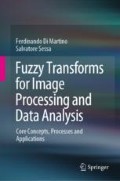Abstract
Data classification is a data mining supervised learning process aimed to classify a set of data points or patterns.
Access this chapter
Tax calculation will be finalised at checkout
Purchases are for personal use only
References
Harrel, F. (2001). Regression Modeling Strategies: With Applications to Linear Models, Logistic Regression, and Survival Analysis (522 pp). New York: Springer. ISBN: 978-1-4419-2918-1.
Panda, M., & Matra, M. (2007). Network intrusion detection using Naive Bayes. International Journal of Computer Science and Network Security, 12, 258–263.
Dimitoglou, G., Adams, J.A., & Jim, C.M. (2013). Comparison of the C4.5 and a Naïve Bayes classifier for the prediction of lung cancer survivability. International Journal of Computer Science and Applications, 6(2), 256–261.
Aha, D.W. (Ed.) (1997). Lazy Learning (432 pp). Norwell (MA): Kluwer Academic Publishers. ISBN: 0792345843.
Jiang, L., Cai, Z., Wang, D., & Jiang, S. (2007). Survey of improving K-nearest-neighbor for Classification. In Fourth International Conference on Fuzzy Systems and Knowledge Discovery (5 pp). China: IEEE Computer Society Press. https://doi.org/10.1109/fskd.2007.552.
Shalev-Shwartz, S., & Ben-David, S. (2014). Understanding Machine Learning (449 pp). Cambridge University Press. ISBN: 978-1-107-05713-5.
Ho, T.K. (1995). Random decision forests. In Proceedings of the 3rd International Conference on Document Analysis and Recognition (pp 278–282). Montreal, QC, 14–16 August 1995.
Ho, T. K. (1998). The random subspace method for constructing decision forests. IEEE Transactions on Pattern Analysis and Machine Intelligence, 20(8), 832–844. https://doi.org/10.1109/34.709601.
Ho, T. K. (2002). A data complexity analysis of comparative advantages of decision forest constructors. Pattern Analysis and Applications, 5(2), 102–112.
Duda, R.O., Hart, P.E., Stork, D.G. (2001). Pattern Classification (2 ed., 617 pp). Wiley. ISBN 978-0471056690.
Pal, S.K., Mitra, S. (1992). Multilayer perceptron, fuzzy sets, and classification. IEEE Transactions on Neural Networks, 3(5), 683–697.
Chaudhuri, C. B., & Bhattacharya, U. (2007). Efficient training and improved performance of multilayer perceptron in pattern classification. Neurocomputing, 34, 11–27. https://doi.org/10.1016/S09252312(00)003052.
Kohavi, R. (1995). A study of cross-validation and bootstrap for accuracy estimation and model selection. In Proceedings of the Fourteenth International Joint Conference on Artificial Intelligence (Vol. 2, No. 12, pp. 1137–1143). San Mateo, CA: Morgan Kaufmann.
Tukey, J. (1958). Bias and confidence in not quite large samples. Annals of Mathematical Science, 29, 614.
Wong, T. T. (2015). Performance evaluation of classification algorithms by k-fold and leave-one-out cross validation. Pattern Recognition, 48(9), 2839–2846.
Wong, T. T. (2017). Parametric methods for comparing the performance of two classification algorithms evaluated by K-fold cross validation on multiple data sets. Pattern Recognition, 65, 97–107.
Di Martino, F., Sessa, S. (2020). A classification algorithm based on multi-dimensional fuzzy transforms. Journal of Ambient Intelligence and Humanized Computing (in press).
Di Martino, F., Loia, V., & Sessa, S. (2010). Fuzzy transforms method and attribute dependency in data analysis. Information Sciences, 180(4), 493–505.
Mitchell, T.M. (1997). Machine Learning (414 pp). Mc Graw-Hill, New York. ISBN: 9780070428072.
Bhargawa, N., Sharma, G., Bhargava, R., & Mathuria, M. (2013). Decision tree analysis on j48 algorithm for data mining. International Journal of Advanced Research in Computer Science and Software Engineering, 3(6), 1114–1119.
Author information
Authors and Affiliations
Corresponding author
Rights and permissions
Copyright information
© 2020 Springer Nature Switzerland AG
About this chapter
Cite this chapter
Di Martino, F., Sessa, S. (2020). Fuzzy Transform for Data Classification. In: Fuzzy Transforms for Image Processing and Data Analysis. Springer, Cham. https://doi.org/10.1007/978-3-030-44613-0_11
Download citation
DOI: https://doi.org/10.1007/978-3-030-44613-0_11
Published:
Publisher Name: Springer, Cham
Print ISBN: 978-3-030-44612-3
Online ISBN: 978-3-030-44613-0
eBook Packages: Computer ScienceComputer Science (R0)

